This set of reissued figurines offers an updated, good-quality variety of animals for collectors who might have missed earlier releases.
Kaiyodo’s miniature dinosaur lines might be among the very best in the market, even with more and more high-end companies entering the scene in recent years. It’s a shame that acquiring Kaiyodo’s figurines hasn’t gotten any easier for collectors outside of Japan – especially in the wake of the 2020 pandemic, and the ensuing shipping bottlenecks which have only made imported goods all the more expensive. Thankfully, Kaiyodo’s products haven’t become entirely impossible to obtain outside of Japan yet, so diligent collectors can still purchase some miniature goodness for themselves through the right channels.
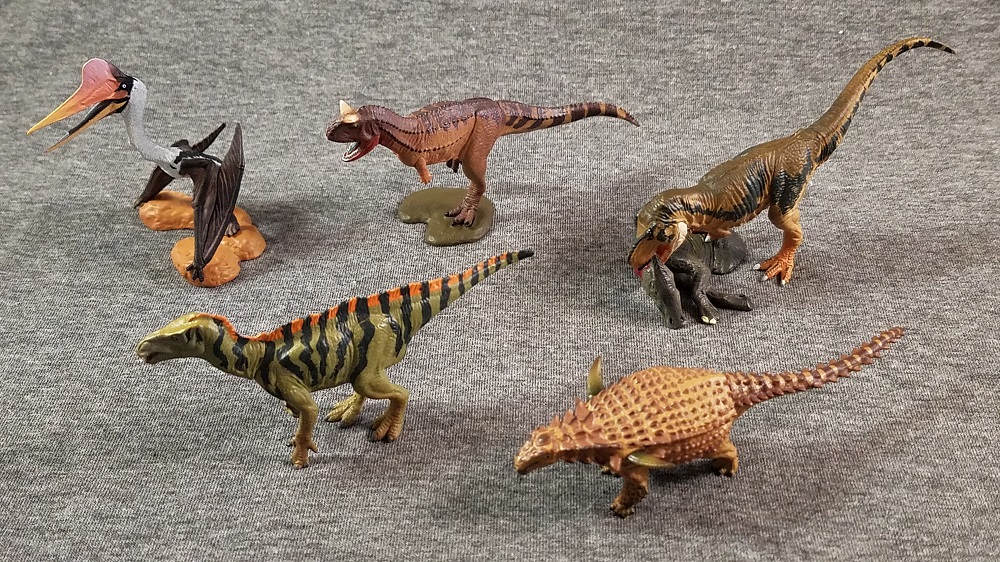
Kaiyodo’s primary dinosaur output for several years was through a dedicated line titled Dinotales by Chocolosaurs, the last of which was released in 2006. In years since, Kaiyodo started releasing dinosaur figures under special Expo sets, as well as their broader Capsule Q Museum line. These sets are often released in promotion with museums and other events, and feature an assortment of new and old models. The quality of plastic Kaiyodo used also changed, becoming softer but also more durable than the somewhat brittle Dinotales figurines. One of these sets, the 7th of the “Dinosaur Excavation” Capsule Q series, was reissued last year after its original release in early 2019; so I took the opportunity to order a set for myself. This set features five prehistoric animals, most of which originated from different Dinotales series sets; however they have all been touched up somewhat for more current reconstructions.

Of the five figures in this set, Borealopelta is the most original – sort of. While this figure marks Borealopelta’s first appearance in Kaiyodo’s lineup, the actual model appears to have been retooled from the Dinotales Series 2 Sauropelta; key differences are in the arrangement of spikes on the neck, now with two rows instead of one, and additional scaling/armoring on the forelimbs and flanks. Only one point of assembly is required: attaching the tail to the rest of the body. Despite these apparent cost-cutting measures in design, the figure still appears largely accurate to what we know of the animal – however I think the skull might be a bit too long for Borealopelta, and there might be a row or two of thoracic osteoderms missing (which would be awkward, considering this is the main & best portion of the animal preserved). Perhaps Kaiyodo devoted their retooling to the wrong place…? Most buyers probably won’t notice this discrepancy, however, and it’s rather impressive Kaiyodo included as many rows of armor as they did at this scale already.

Detail certainly isn’t lacking on this miniature. Despite measuring only 10 cm (4 in) long, each osteoderm on the body is individually sculpted, and there are even smaller additional ridges and scales sculpted between the rows on both the back and flanks. The throat and belly feature a grid pattern of scales, with creased folds of skin at the base of the tail. The legs are smooth apart from armor, but some musculature and bone is evident around the calves and ankles; and each toe on the feet is distinct. The face also features distinct eyes, nostrils, and mouth/beak lines. Coloration is fairly simple, but equally applied with care: the body is a light muddy brown, with a darker mocha hue applied to each plate and scute of armor. Some of the larger armor bits near the front of the body have additional black highlights, with additional grey-black apps to the beak, toes and forelimb armor. The eyes are precisely painted yellow with black pupils, and dark brown banding on the tail adds extra contrast to the typical business end of armored dinosaurs. The two major shoulder spikes get the best attention with incredibly lifelike black-and-brown gradient tones, resembling real keratin sheaths.
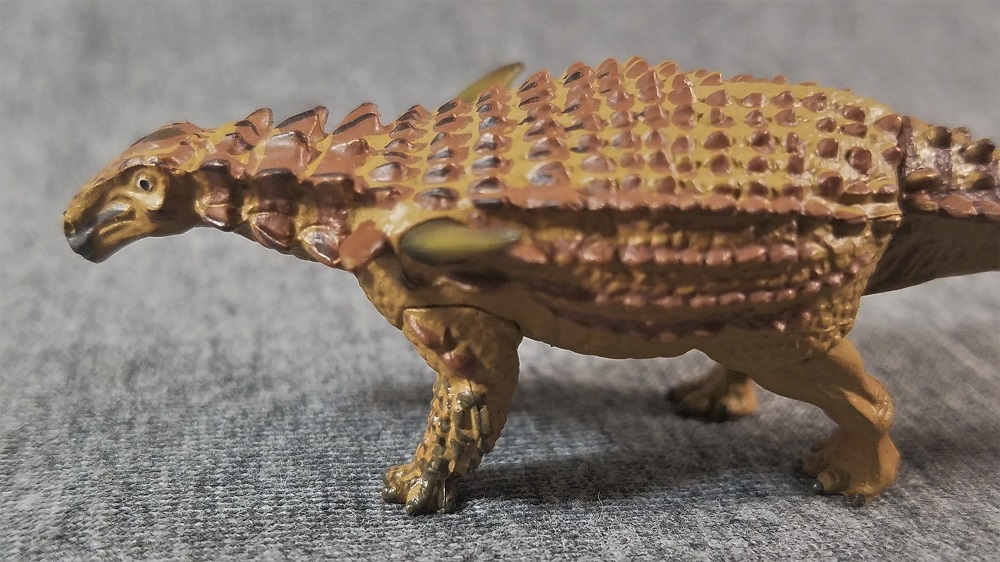
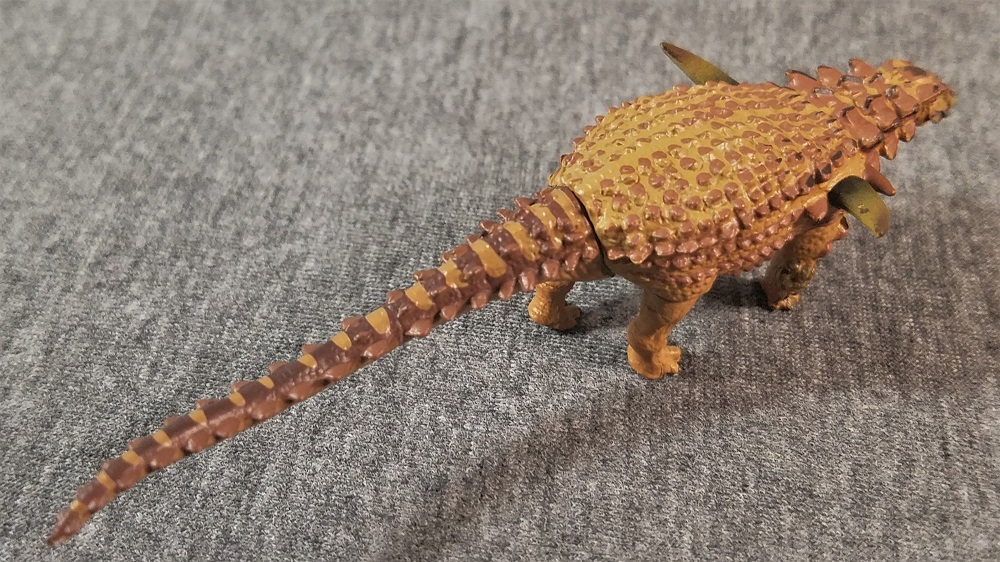
Similarly retooled is the Carnotaurus, which closely resembles Kaiyodo’s prior version of the animal from Dinotales Series 5. The figurine retains the aggressive running stance, balanced on one foot with arms slightly tucked and jaws open for attack. However, there are some subtle differences to indicate Kaiyodo has updated the design since then. The neck looks shorter and stockier on the newer version, and the body seems slightly more robust. The tail appears more gently curved, and the teeth and osteoderms appear a little finer. The larger scales are still arranged in neat rows down the body and tail (the commonly-accepted depiction of Carnotaurus skin texture until 2021, when new studies suggested more erratic arrangements of these scales) with creased and wrinkled texture to the skin regions around the neck and legs where the body is most flexible. The skull appears lacking in soft tissues, but is otherwise quite precise in reconstruction, with the animal’s signature pair of horns sticking out at a straight angle and rather pointy to the touch.
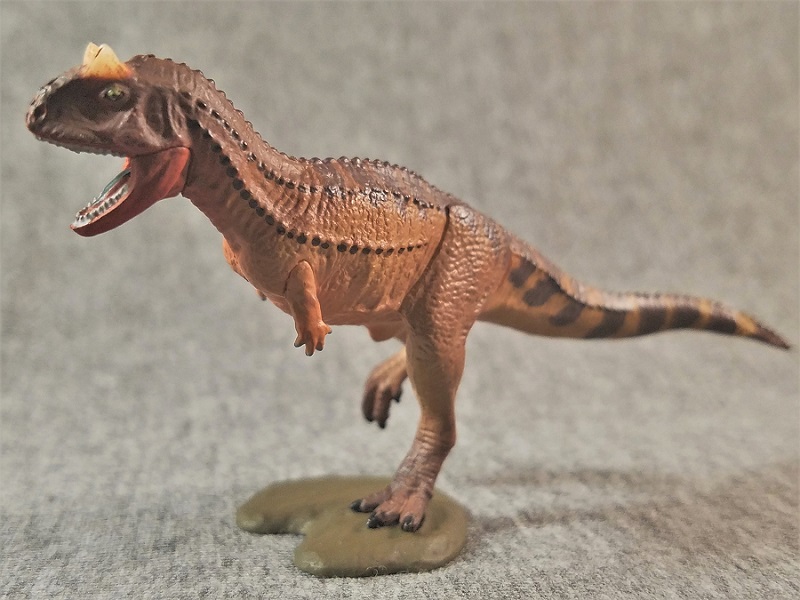
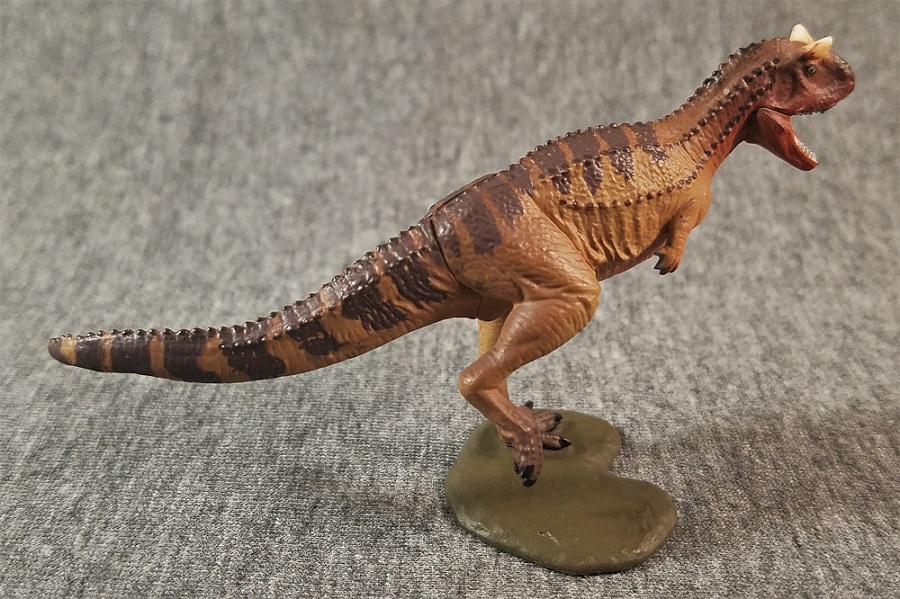
The Carnotaurus stands balanced mid-run on its left foot, inserted into a flat plastic base. While the original Dinotales version featured a base modeled like a carcass, the Capsule Q version is a more nondescript mud flat. Detailing aside, the figurine is a bit delicate to balance; but as long as it’s undisturbed it actually holds the pose perfectly fine. The paint scheme is another area that’s more modest than the original, although the new scheme is by no means bad. Carnotaurus is primarily colored in light & dark browns like the Borealopelta, with thick dark stripes running perpendicular to the spine from the shoulders down tail. The head is dark red in color, slowly transitioning to brown down the neck; and the horns are a stark bony white. Each of the large scales (and the toe claws) are individually painted black, as are the fingers in gray and the eye outlined with black and yellow. The teeth are painted together in white, and even the tongue is painted (…blue? Okay, it’s a unique touch). All in all, this is still a very fine representation of the “meat-eating bull”.
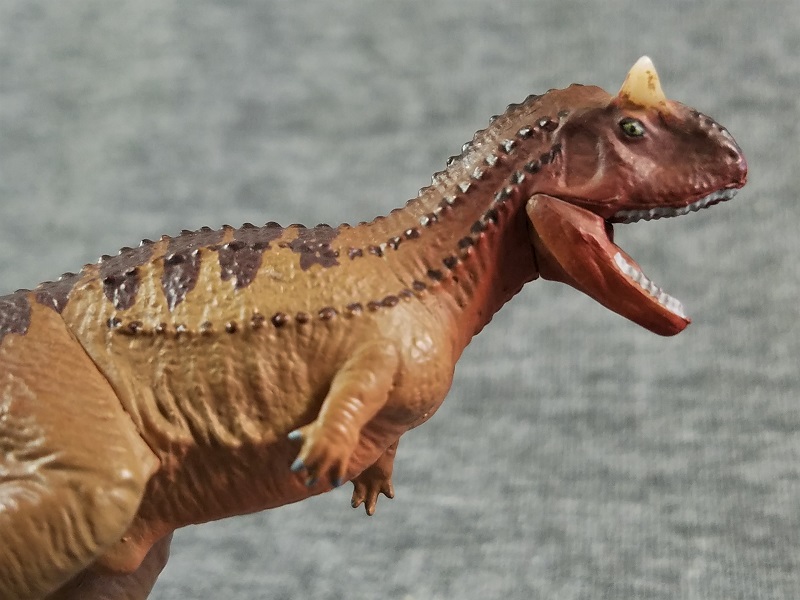
There are two herbivores featured in this Capsule Q set, the first of which was Borealopelta. The second featured herbivore is Iguanodon, reissued from the 6th Series of the Dinotales line. Unlike the Carnotaurus, the color scheme for Iguanodon has actually become more dramatic for this release, with thick, dark blue-green vertical stripes over a muted base green. A stark orange stripe runs along the spine, and additional ruddy accents are applied to the belly, mouth and feet. It’s not too gaudy of a color scheme, but it is effectively eye-catching. One can easily envision this animal using its coloration to communicate inter-specifically or to camouflage from and confuse predators. Fingers and toes are neatly painted once again, with a precision that is the envy of many models at much larger scales. Besides the color scheme, the primary difference from earlier Dinotales version is the addition of a short “sail”, or fringed membrane of tissue along the spine for display (this is a purely speculative feature, to my knowledge).
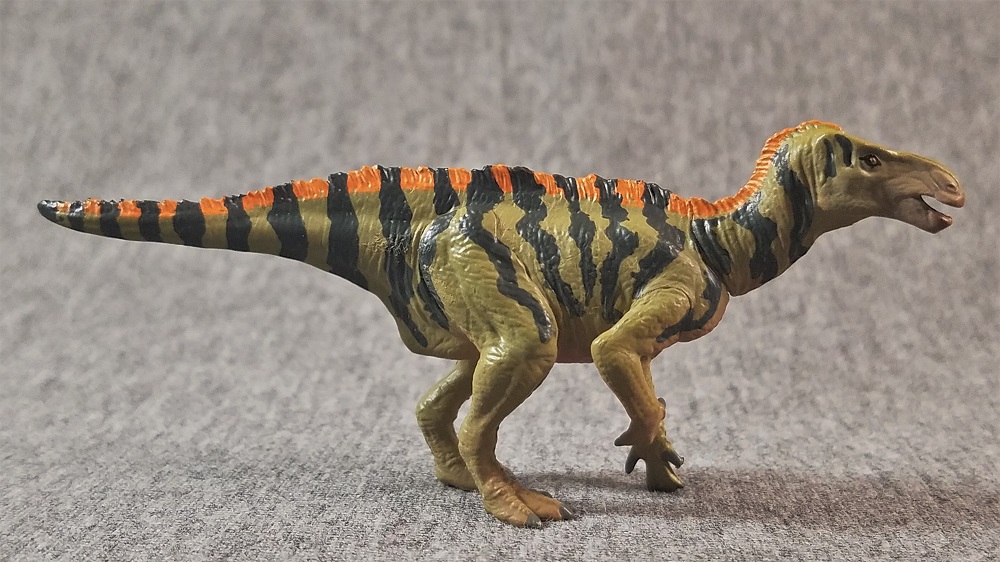
Anatomically speaking, the Iguanodon is pretty accurate for the designated species I. bernissartensis, although the details are less precise than the paint apps. The skull reflects the distinct boxy look the bernissartensis species is known for; however it looks a little long in proportion to the neck and body on this figurine. The tail appears noticeably reduced, although I speculate this was a choice made for ease of durability and packaging. The torso and forelimbs also look like they could afford to be a little more robust; however the front feet are correctly positioned with palms facing inwards, balanced on the three middle toes with the iconic thumb spike sticking forward.
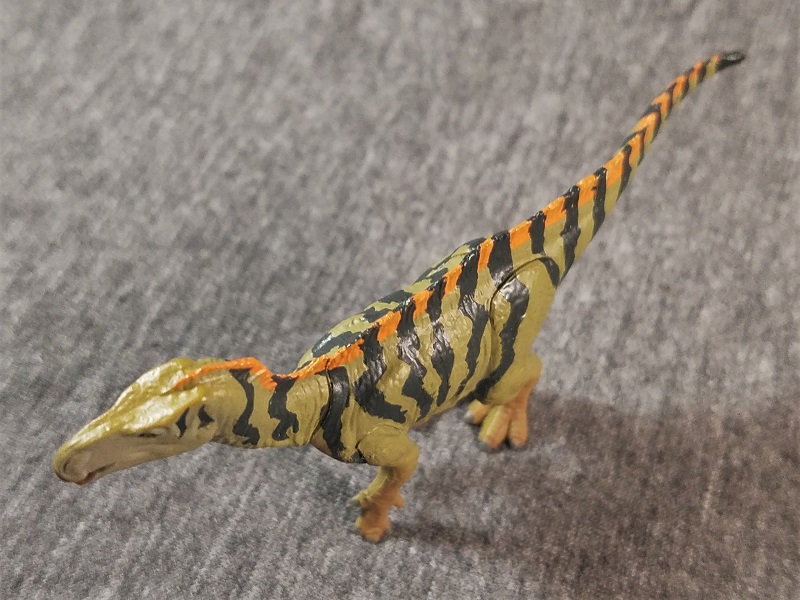
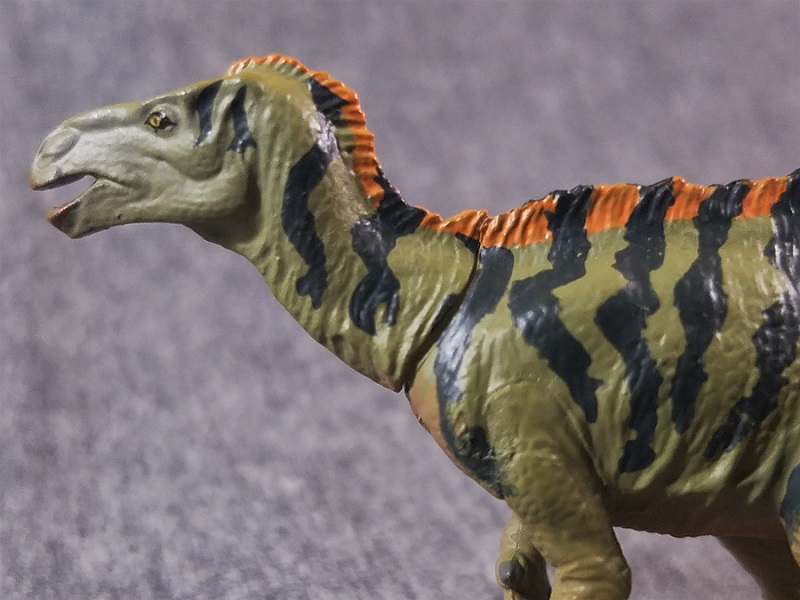
Technically, I could say there are actually three herbivores in this set; but the “third” herbivore, Saurolophus, is actually a glorified base/accessory to the true main figurine: the theropod Tarbosaurus. The predator is posed bending over its freshly-killed hadrosaur prey, one foot upon the torso for balance, teeth sinking into the carcass’s neck (neatly fitted into a molded bite mark). This giant tyrannosaur was originally released in the 4th series of Dinotales figures, and appears to have been largely unchanged for this release. Kaiyodo’s figurine matches known skeletal dimensions very well, and depicts a robust image fitting for the animal. The skull, although a bit wide, is unmistakably tyrannosaurine, sturdy and massive in proportion. The neck and body are quite stout, with the minute arms tucked in and correctly oriented. The figurine appears well-muscled, and additional layers of baggy skin sit wrinkled and creased on the neck, flanks, and base of the tail. This is a very fit and healthy Tarbosaurus; the only quirk of real notice would be the oddly protruding ischium behind the legs.
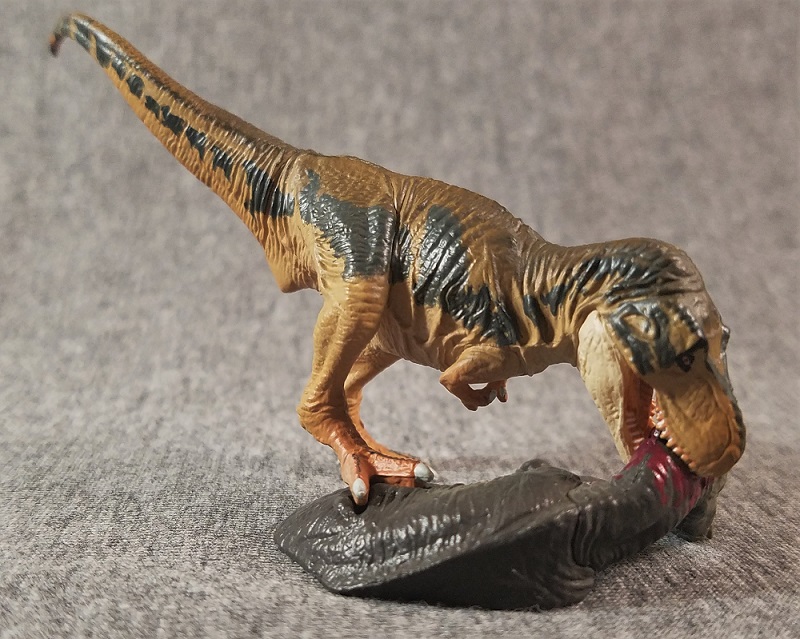
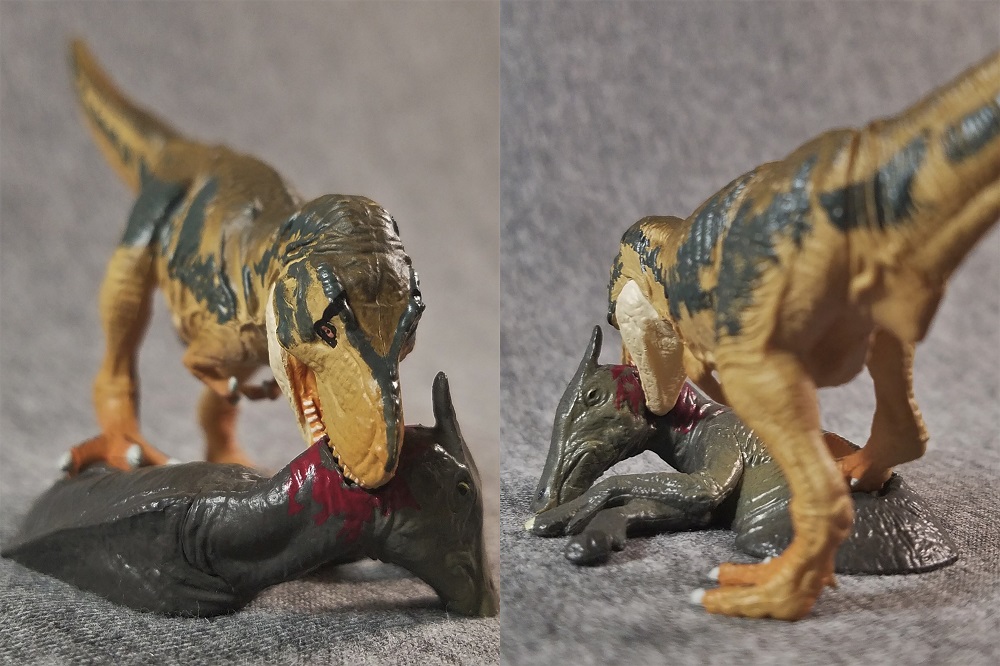
Like the other figures in this set, the one feature of Tarbosaurus that has been noticeably changed since the original Dinotales release is the color scheme. As with the Carnotaurus, the brighter original patterns are replaced with a more conservative scheme: dark brown on top fading to yellow-tan underneath, punctuated by splotchy black contour striping. Additional highlights include creamy white on the throat and lower jaw, and light orange hands and feet. It’s another attractively naturalistic color scheme which fits the model quite well, and is generally applied very neatly. The eyes are once again expertly marked, and the teeth are individually painted over pinkish gums. Regrettably, Saurolophus fares less well in the paint department, having been reduced to mostly monochrome muddy gray. A couple of toenails remain painted white, and the eyes and nostrils are carefully painted black.

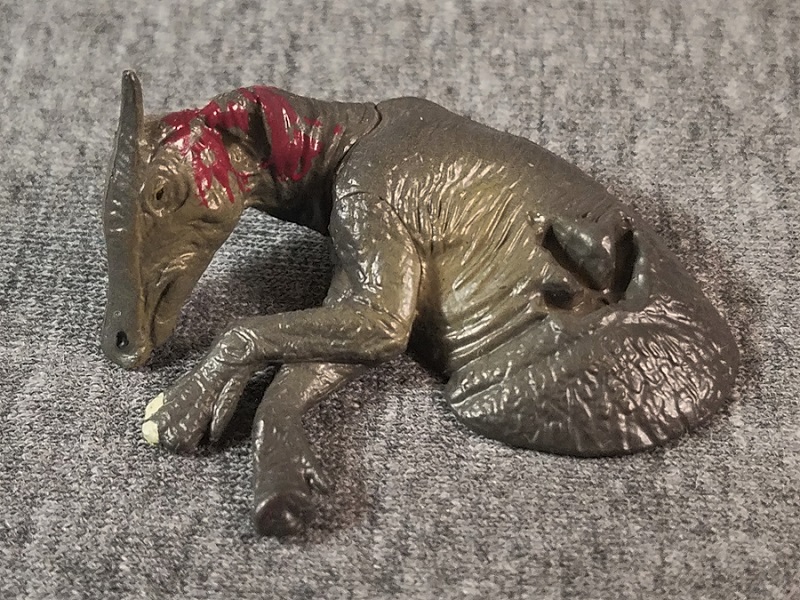
The fifth and last figure of this set is not a dinosaur, but the giant pterosaur Quetzalcoatlus, posed semi-crouched on a rocky outcrop. Originally released by Kaiyodo in the 6th series of Dinotales figures, the Capsule Q version features a revised neck & head sculpt, with the neck being longer and the skull longer and straighter. Quetzalcoatlus and other azhdarchids had quite the extraordinary body proportions, and these revisions bring the figure closer to what we currently know about their appearance. The beak is straight and narrow, with a semicircular crest over the eyes. The neck is curved back in a half-S arc, within the known range of azhdarchid neck flexibility. The limbs are appropriately long, and while the arm bones and wing fingers aren’t quite correct in proportions, they do appear very close. The hands, posed clutching the rocks, are incorrect; a more up-to-date design would feature the hands pointed nearly backwards at an angle. The wing membranes and torso look fairly accurate, however, and the body features a subtle sculpted coat of pycnofibers.
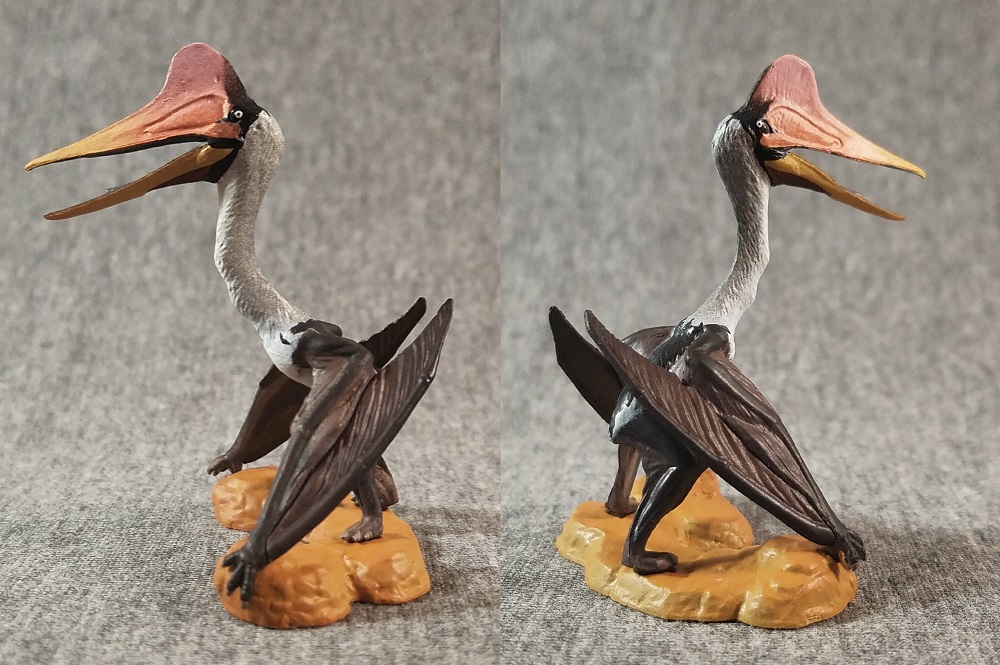
Coloration for Quetzalcoatlus is mostly black and white patterns, with a bright pink-and-yellow beak and slightly reddish-brown wing membranes. It’s a color scheme very reminiscent of modern seabirds – which, although applied nicely on this figurine, is something of a cliché by now, and possibly an inaccurate one since Quetzalcoatlus was more likely an inland animal. A color scheme inspired by large ground & game birds might be more appropriate for the giant pterosaur. Having said that, the Capsule Q Quetzalcoatlus still looks quite good, and the chosen color scheme helps the pterosaur stand out from the more brownish dinosaurs included in the set.

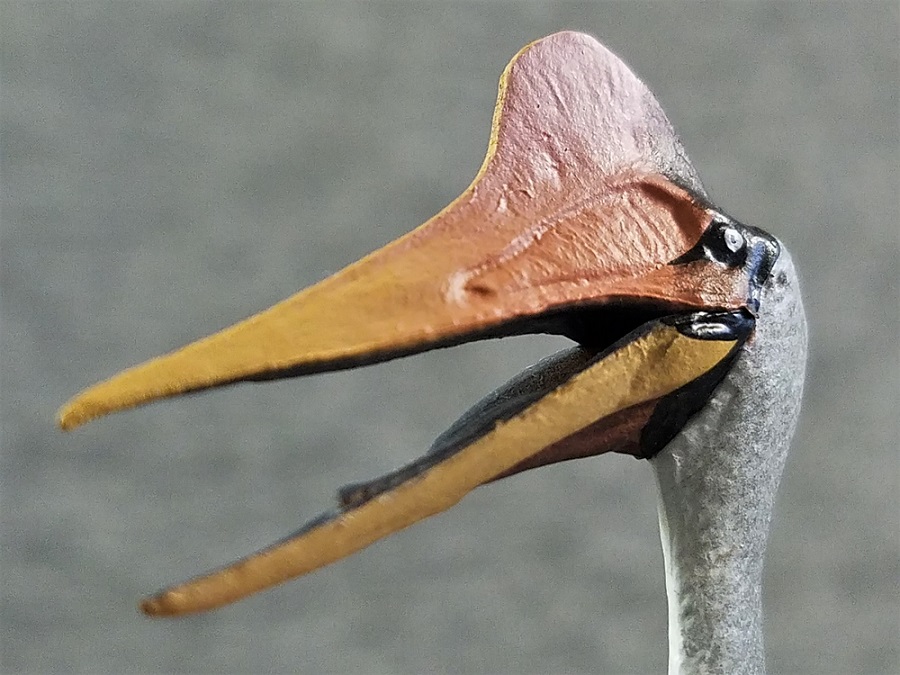
While the 7th Dinosaur Excavation set in Kaiyodo’s Capsule Q line isn’t exactly new in terms of content, it’s still a solid set of high-quality figurines depicting largely up-to-date renditions of new and old Mesozoic genera. Kaiyodo continues to release what are among the nicest prehistoric animal toys on the collectibles market. Sadly, acquiring these figures can be difficult outside of Japan, but they do pop up at various prices on eBay and Mercari. You can also try looking around for middleman services who might be able to provide better prices.
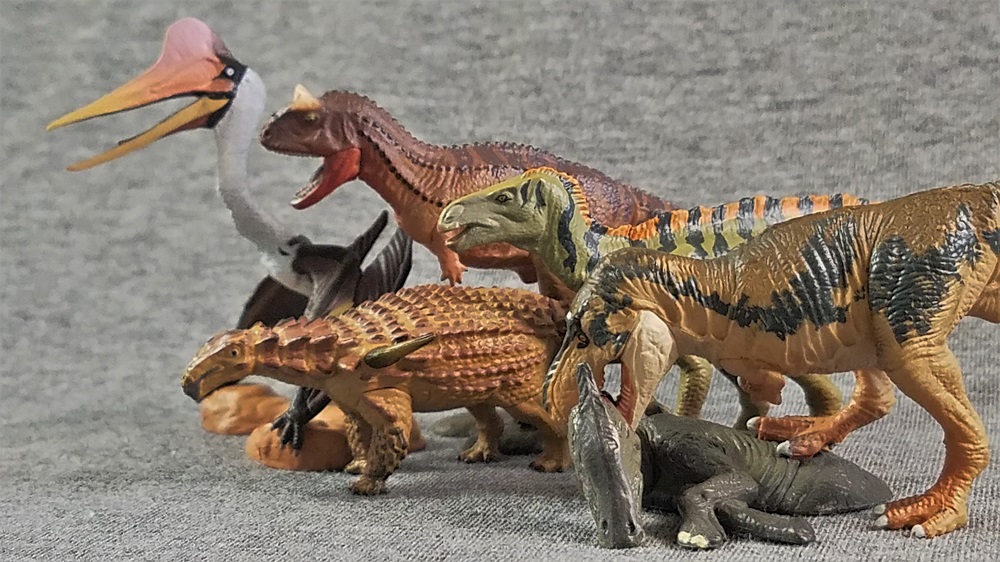
Disclaimer: links to Ebay and Amazon on the DinoToyBlog are affiliate links, so we make a small commission if you use them. Thanks for supporting us!




They sell these at forbidden planet (comic shop in NYC) for about 6-7 bucks a pop. I got the Iguanadon from there